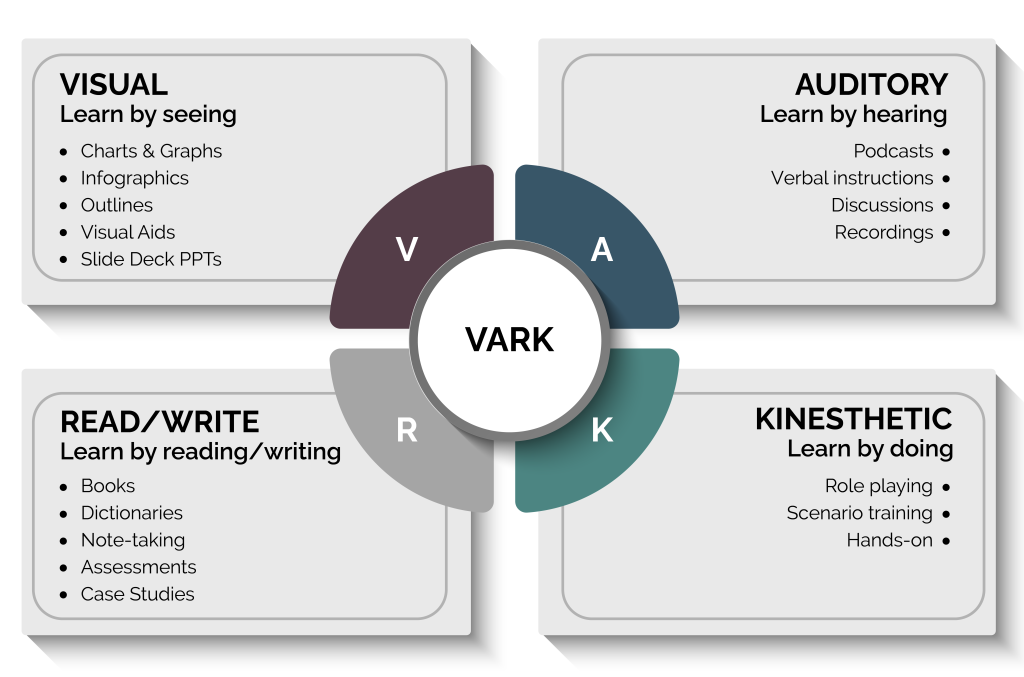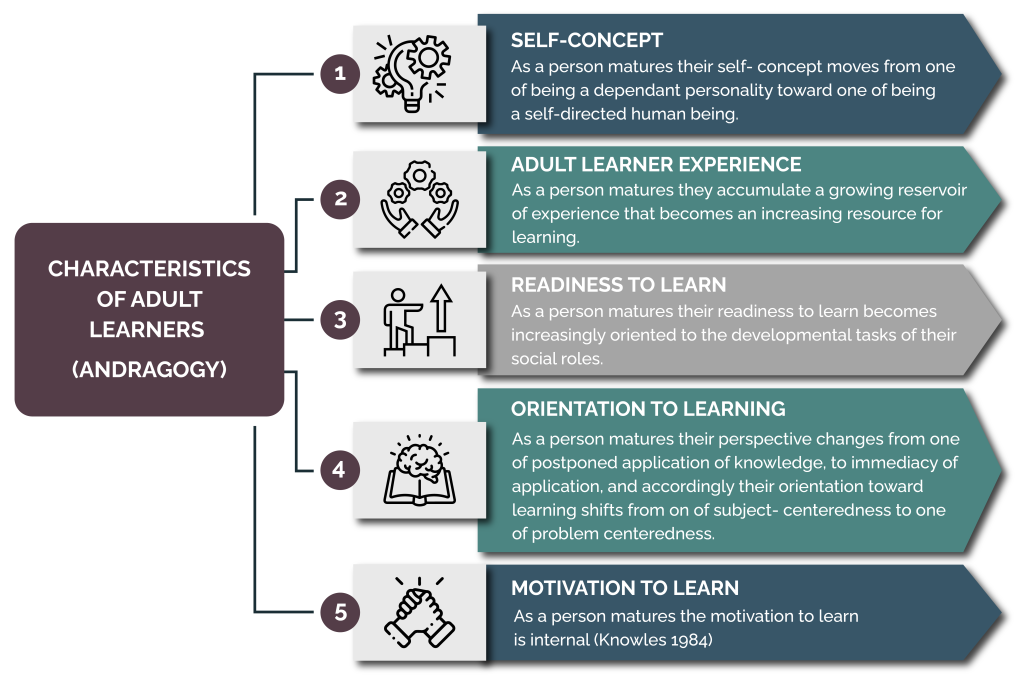Fixed vs. Fluid Learning Styles
In the understanding of how people learn, there has been a longstanding discussion on whether or not individualized learning styles exist and if they have any influence on a learner’s retention of knowledge. Sarasin (1999) defines learning styles as “The preference or predisposition of an individual to perceive and process information in a particular way or combination of ways.” While many scholars do agree that individuals all learn and process information differently, many do not believe in the commonly discussed VARK model proposed by Neil Fleming (shown below), which divides learners into four primary learning styles, including visual (learning through graphs, charts, diagrams), aural (learning through discussions, guest speakers, recordings), read/write (learning through lists, notes, and text), and kinesthetic (learning through practical exercises, trial, and error, case studies). This model falls under the presumption that learning styles are fixed. In addition to lacking scientific evidence and research, this theory places unnecessary labels and limitations on how an individual should learn.
 Instead, a more fluid model of learning styles is more readily accepted, which states that there are many other approaches to learning than the traditional four and that preferred learning styles change over time and depend on the context of the knowledge and task. The fluid viewpoint of learning styles proposes that there are several factors to consider when creating and presenting content, with learning styles being just another component of that. Proponents of the fluid model of learning styles assert that learning styles are less about restricting learning. Instead, they should be used as tools for the learner to know and understand their style of education, which gives them the power to achieve effective learning and knowledge acquisition. In research on the impact of understanding one’s learning styles on academic progress, the author found that “when students understand how they learn best, they inevitably adjust conditions and devise strategies for facilitating their progress” (Dunn et al., 2009). There are several other learning style theories that have attempted to expand upon the earlier VAK and VARK model such as David Kolb’s model, which focuses on experiential learning and the learning process, Peter Honey and Alan Mumford’s model, which stages learning cycles according to the learner’s experience level, and Anthony Gregorc’s model based on concrete vs. abstract and logical vs. non-ordered information. Each of these takes a more fluid stance on learning, basing the styles upon each individual’s background knowledge, the complexity of the context, and other outside factors which are flexible to the situation and individual.
Instead, a more fluid model of learning styles is more readily accepted, which states that there are many other approaches to learning than the traditional four and that preferred learning styles change over time and depend on the context of the knowledge and task. The fluid viewpoint of learning styles proposes that there are several factors to consider when creating and presenting content, with learning styles being just another component of that. Proponents of the fluid model of learning styles assert that learning styles are less about restricting learning. Instead, they should be used as tools for the learner to know and understand their style of education, which gives them the power to achieve effective learning and knowledge acquisition. In research on the impact of understanding one’s learning styles on academic progress, the author found that “when students understand how they learn best, they inevitably adjust conditions and devise strategies for facilitating their progress” (Dunn et al., 2009). There are several other learning style theories that have attempted to expand upon the earlier VAK and VARK model such as David Kolb’s model, which focuses on experiential learning and the learning process, Peter Honey and Alan Mumford’s model, which stages learning cycles according to the learner’s experience level, and Anthony Gregorc’s model based on concrete vs. abstract and logical vs. non-ordered information. Each of these takes a more fluid stance on learning, basing the styles upon each individual’s background knowledge, the complexity of the context, and other outside factors which are flexible to the situation and individual.
Applying Learning Styles to Adult Learning
One learner category where learning style consideration may be most pertinent is adult learners’ teaching. Adults, in particular, learn differently from younger learners because they come into the learning environment with previous work and life experiences before academic knowledge and often prefer the ability to take control of their learning progression. According to the principles of adult learning developed by Malcolm Knowles (1980), adult learners are self-guided, draw upon past experiences, have an increased readiness to learn, more often transition teaching into practice, and are internally motivated to learn. Since adult learners are particularly self-guided and provide unique vantages for each learning opportunity, making each adult learner aware of their learning preferences dependent on the context and situation can help them to adapt better and facilitate their learning process. Making learners more aware of their learning styles, the impact that knowledge can have on learning, and how to make the best of this knowledge can be many ways educators assist the evolution of more reflective, motivated, satisfied, self-directed adult learners.
 Considering Content
Considering Content
Although learning styles and understanding them may give insight into each individual’s preference for consuming information, this does not directly relate to a learner’s effectiveness in knowing and retaining content. Thus, the best format for presenting content has less to do with learning preferences and more to do with the substance of the content, learners’ existing knowledge, and the circumstances under which learners will consume and use the information.
One factor that instructional designers must consider is how different learning or teaching approaches lend themselves to other content. For example, an extensive infographic job aid illustrating a complex procedure containing numerous steps may not be the best tool to utilize when teaching an employee who has never seen or done the process themselves. Instead, a video demonstration or hands-on approach would be more effective in teaching said content, followed by visual aids to support said learning as a reminder to remember critical steps.
Similarly, one must consider the complexity and type of content and the prior knowledge level of each learner. For example, a brief safety presentation may not be sufficient to teach new employees how to operate machinery properly because they have no prior information regarding the equipment in the discussion. Whereas for a senior employee, a refresher video that discusses the essential safety points would most likely suffice.
Although learning styles should not be the sole basis upon which content is developed, they can provide an excellent understanding of how they prefer to learn and strategize to achieve their learning goals. Aside from the knowledge of each person’s learning styles, instructional designers separately should take into consideration the different forms of learning techniques and how each one relates to other content areas and levels of understanding to ensure that not only is content understood, but that it will be retained and utilized long term.
At Radiant Digital, our team of instructional designers understands the importance of curating individualized plans for achieving learning goals. Each learning module is designed to best support the content being delivered and the type of learner being taught.
Citations:
Dunn, R., Honigsfeld, A., & Doolan, L. (2009). Impact of learning-style instructional strategies on students’ achievement and attitudes: Perceptions of educators in diverse institutions. The clearinghouse, 82(3), 1.
Sarasin, L.C. (1999). Learning Style Perspectives: Impact in the Classroom.


